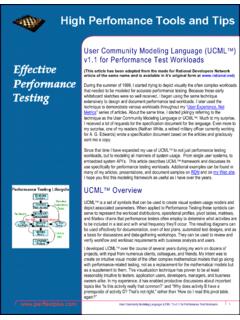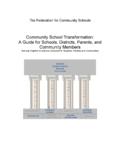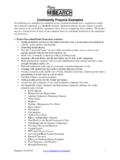Transcription of Community Health Planning
1 1 AMERICAN Health Planning ASSOCIATION December 15, 2008 Community Health Planning By John Steen Community Health Planning is a deliberate effort to involve the members of a geographically defined Community in an open public process designed to improve the availability, accessibility, and quality of healthcare services in their Community as a means toward improving its Health status. That public process must provide broadly representative mechanisms for identifying Community needs, assessing capacity to meet those needs, allocating resources, and resolving conflicts. The challenge that Community Health Planning addresses is that of making the healthcare system more accountable to average residents in their communities.
2 The policy rationale for this is that of bringing private interests in healthcare delivery into better alignment with public interests. From the beginning of national Community Health Planning in the establishment of Comprehensive Health Planning Agencies in 1966, the federal government explicitly operationalized a commitment to providing consumers, including minorities and the poor, the opportunity to play a policymaking role in Planning , delivering, and evaluating the healthcare services for which they are in greatest need. Community Health Education If it is to constitute a Community benefit, the process conjoining consumer and provider, layperson and professional, Community and provider organizations in partnership, must recognize and operationalize a set of imperatives involving the sharing of information which is personally meaningful to each participant in each of the roles played by the participant in the Community .
3 The information about Community Health status, Health problems, and resources must be assimilated and integrated by each participant into his or her understanding of the Community and its value system before the participant is asked to base decisions about resources and needs on it. The requisite decisions are judgments which are made by the participants acting on behalf of the Community -- a fiduciary responsibility they may be expected to meet only if their judgment is informed. Therefore, the sponsor of a Community Health needs assessment should understand the nature and extent of the obligation it assumes through its sponsorship: To support Community discussion in which each participant understands the bearing and relevance of all of the major factors -- in epidemiology and sociology, in the Health care system and the Community which contribute to, and complicate, his or her judgments.
4 Given the scope and complexity of those factors, it is a daunting challenge for a sponsor to meet its obligation. It is by operationalizing respect for the Community that a sponsor induces the Community to become vested in the partnership in which responsibility for improving the Health of the Community is shared. Planners show respect by becoming aware of their Community s 2concerns, and officials demonstrate their willingness to be accountable to their constituents in how they use resources. Respect is shown too by recognition of the validity of Community judgments even when they differ from more rigorous professional judgments.
5 The predominance of the instrumental approach to Health promotion reflects the bias in favor of measuring the efficacy of interventions in behavioral terms rather than in normative terms that consider the intention of people to achieve well being by living a good life. If we truly wish to promote their Health , we must promote their ability to think for themselves and exercise their own judgment. Our intent must be their empowerment and not their manipulation. Community Engagement The Institute of Medicine has described the proper use of Community assets by public Health : Communities and Community organizations can be vital contributors to the resources and capacity of a public Health system.
6 A Community s right to self-determination, its knowledge of local needs and circumstances and its human, social, and cultural assets, including the linkages among individuals, businesses, congregations, civic groups, schools, and innumerable others, are all important motivations for Community Health action. In cases in which Community Health promotion and protection activities are initiated by a Health department or an organization, engaging the Community is a primary responsibility. Realizing the vision of healthy people in healthy communities is possible only if the Community , in its full cultural, social, and economic diversity, is an authentic partner in changing the conditions for Health .
7 1 The Community Health Planning process can be used to create coalitions to identify and to address Community Health needs and Their functions may include: Undertaking Community Health needs assessments and Community Health improvement projects; Receiving Health education to enable spokespersons to exercise informed judgment on Health policy issues; Mobilizing Community Health initiatives; and, Building capacity to address Community priorities. Through the experience acquired in performing such functions, coalitions can then provide a voice for: How Health plans serving their communities are governed; How quality of care is measured; Making the Health care system more responsive to consumer needs; Planning and developing services to meet their needs, and evaluating results; 3 Providing oversight for provider initiatives; Validating the missions of Health care systems; Improving the Health status of all of their members; and, Determining how societal resources are distributed.
8 The significance of such a Community Health Planning process is captured in the realization that it is unique for examining the way in which the entire healthcare system is organized in a Community , and how it interfaces with all the Community s needs. The legitimization of that process derives from its embodiment of the best principles of democracy and good government, but most of all, by the validation of the Community that supports and participates in it. Regulatory Activities In the context of Community Health Planning , certificate of need (CON) and licensure regulations are seen as policy tools for implementing local and state Health plans.
9 A state Health plan can incorporate general policies for the state s delivery system as well as service specific standards against which regulators may measure proposals. Certificate of need is a public process which makes healthcare providers accountable for meeting access, quality and cost standards, and provides a context within which provider initiatives may be evaluated against alternatives for meeting state priorities for improving the Health status of its citizens. New York State invented CON in 1964-65 through legislation which declared as its policy and purpose that hospital and related services of the highest quality, efficiently provided and properly utilized at a reasonable cost, are of vital concern to the public Health .
10 The essential function of CON programs is to transform private business plans into public information. The best programs also use an open public process to draw up a state Health plan, and public hearings in the review of CON applications. Although CON is not proactive, ultimately having to choose among provider proposals, it does provide the opportunity for negotiations in which plans may be improved. Within their statutory authority, CON programs can make their approvals contingent on state Health plan provisions and policies, and on the concerns they hear from their communities. And by reviewing a batch of similar applications competitively, they can establish a process in which providers are motivated to best satisfy considerations reflecting the public interest.








